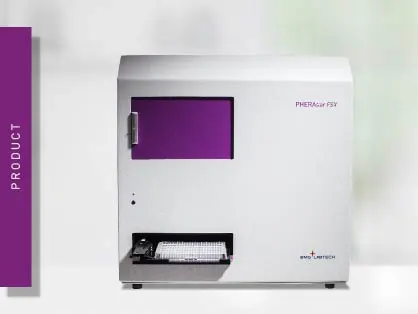
PHERAstar FSX
Powerful and most sensitive HTS plate reader


Expand detection capabilities with enhanced dynamic range, ensuring accurate signal quantification across low and high concentrations.
Dynamic range is defined as “the ratio between the largest and smallest value that a certain quantity can assume”. In the context of microplate reader-based detection, the dynamic range refers to the extent of either sample concentrations/dilution or signal intensities that a reader is capable of measuring in a single detection run.
As an example, if the lowest sample concentration measured is 1 µM and the maximal 1,000 µM, then the respective dynamic range spans from 1 to 1,000 and covers three decades of concentrations.
In empiric science, sample signal intensities might span over more than three decades, for instance in experiments where the highest concentration is one million times higher than the lowest (1 to 1,000,000, equals 6 decades). An instrument being able to detect both signals in a single measurement run covers a dynamic range of six decades.
Analytes often cover a vast range of concentrations, making sample signals that have to be measured on a plate reader, span over a wide range of signal intensities – from dim to very bright. In addition, samples of enzymatic or cell-based kinetic assays are often hard to predict in their signal intensity, as their maximum signal builds up over a lapse of time during the course of the kinetic.
This high variability can be hardly covered by a narrow dynamic range. Specifically, low signals might not be distinguishable from negative controls/blanks or high signals might result in an overflow of the signal detector as both are “outside” of the dynamic range. To cope with this issue, multiple measurements of the same plate are required in order to cover the whole range.
This is more complicated for kinetic assays. Here users usually have to find a compromise between sensitivity and width of the dynamic range. In the case of detector saturation because of out-of-range signals, the kinetic has to be repeated with a lower fluorescence gain or luminescence gain value. This results in a waste of time and reagents. The Enhanced Dynamic Range (EDR) technology prevents these issues.
EDR is available on the PHERAstar FSX, CLARIOstar Plus and VANTAstar plate reader and is specifically designed to offer the largest possible dynamic range - 8 concentration decades. This provides researchers with an unprecedented convenience in microplate measurements as highly reliable results can be measured over a large dynamic range with no manual intervention.
In order to understand the principle of EDR technology, conventional signal detection needs to be explained first. The light signal of the sample in a microplate well is directed to a detector, a photomultiplier tube (PMT). The PMT transforms and multiplies the energy of photons into a detectable electrical current.
The incoming light signal can be amplified by an amplification factor: the gain. More precisely, the gain is the voltage of the detector at which the incoming light signal is amplified. In other words, changing the gain moves the dynamic range of detection along the concentration curve of the analyte/assay. However, the width of the dynamic range is fixed and does not change. Find out more about gain and how it influences your measurements in the HowTo Note: How to optimise the gain setting of your microplate reader? This note includes examples which highlights the impact an inappropriate gain value can have on measurement data.

Measuring with a fixed gain, either manually set beforehand or automatically determined by the reader, ensures that only a limited range of signal intensities (usually 5-6 concentration decades) are reliably detected. Any sample displaying a much higher or lower signal cannot be consistently measured as outside of the dynamic range.
EDR makes it possible to measure very bright and dim signals in the same measurement – no gain setting required.
EDR significantly simplifies measurement setup and provides an easier solution for assay development. It ensures reliable detection of samples at a large range of concentrations and signal intensities with no manual intervention.
EDR will save you time and money as it eliminates the need for repeated detection runs to acquire highly divergent samples at different gain settings.
Moreover, it allows you to compare data that have been measured with the same assay kit at different time points with each other.
EDR technology brings the following advantages to your lab:
EDR can be applied to any wavelength in fluorescence intensity and luminescence. On the CLARIOstar Plus and VANTAstar is can be used both with filters and LVF Monochromators.
Powerful and most sensitive HTS plate reader
Most flexible Plate Reader for Assay Development
Flexible microplate reader with simplified workflows